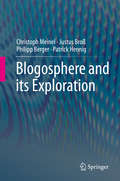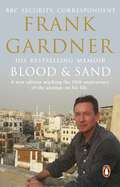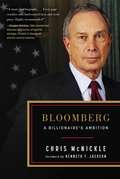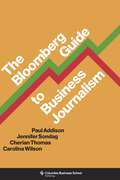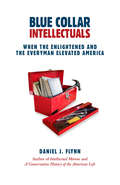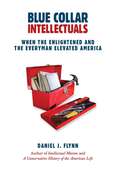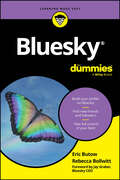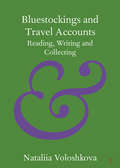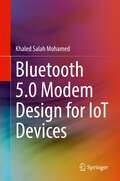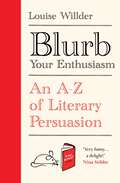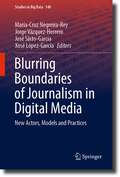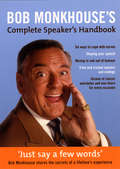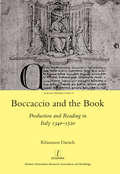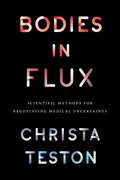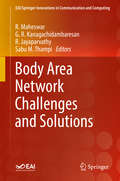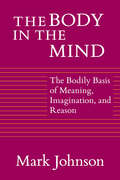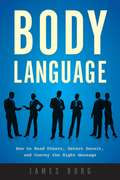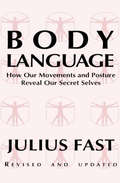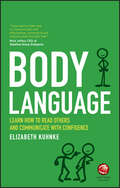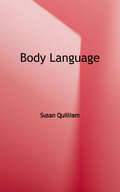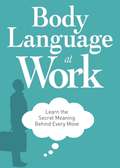- Table View
- List View
Blogosphere and its Exploration
by Christoph Meinel Justus Broß Philipp Berger Patrick HennigThis book represents an attempt to fully review the phenomenon of the blogosphere. The intention is to provide a reliable guide to understanding and analyzing the world of the unimaginable number of diverse blogs, each consisting of innumerable posts, which in their entirety form the blogosphere. We go on to answer the questions of how to grasp the complexity of the blogosphere and extract useful knowledge from it. In setting out to write this book, our central aim was to increase the reader's awareness and understanding of the blogosphere phenomenon, including its structure and characteristics. This can be achieved through a better understanding of individual blogs and their particular technical characteristics, as well as a deeper knowledge of how a single blog is embedded and interconnected within the entire blogosphere. The shape and form of the blogosphere can be described using the analogy of different continents. In our description the defining features and characteristics of the continents are illustrated by paradigmatic example blogs. Following on from the structural analysis we provide details of the available methods and describe the complex challenge of automatically retrieving information from the abundance of data contained in the blogosphere. Finally, we present our blog search platform, called BLOGINTELLIGENCE and describe all the tools and features we have developed during the last couple of years to explore the blogosphere.
Blood and Sand: The BBC security correspondent’s own extraordinary and inspiring story
by Frank GardnerOn the June 6, 2004, while on assignment in Riyadh, BBC security correspondent Frank Gardner and cameraman Simon Cumbers were ambushed by Islamist gunmen. Simon was killed outright. Frank was hit in the shoulder and leg. As he lay in the dust, a figure stood over him and pumped four more bullets into his body at point-blank range...Against all the odds, Frank Gardner survived. Today, although partly paralysed, Frank continues to travel the world, reporting and making documentaries for the BBC. This acclaimed memoir was brought up to date with a new chapter that recounted his return to Saudi Arabia for the first time since he was shot and the story he tells continues to move and inspire, and remains an affirmation of his deep understanding of - and affection for - the Islamic world in these uncertain times.___'Gardner tells his remarkable tale well and bravely, with an astonishing lack of anger and enduring love and respect for the Islamic world' SUNDAY TIMES'Brave, unsentimental and genuinely inspiring' EVENING STANDARD 'What makes Gardner's moving, often humorous, deeply personal story so important is the fact that he has woven into it a brilliantly dispassionate, clear-eyed account of the Islamic world' SCOTSMAN'A witty, self-deprecating, inspiring testament' DAILY TELEGRAPH
Bloomberg: A Billionaire's Ambition
by Chris McNickleExamine the Bipartisan Legacy of a Remarkable Billionaire PoliticianBloomberg: A Billionaire’s Ambition tells the story of how one of America’s most successful entrepreneurs was elected mayor of New York City and what he did with the power he won. Bloomberg’s stunning victory against all odds just weeks after the 9/11 terrorist attack left him facing challenges unlike any mayor in history. For the next twelve years, he kept the city safe, managed budgets through fiscal crises, promoted private sector growth, generated jobs, built infrastructure, protected the environment, supported society’s cultural sensibilities, and achieved dramatic improvements in public health. Bloomberg was an activist executive who used government assets boldly and wisely for the greatest good, for the greatest number of people. His time as mayor was not without controversy. Bloomberg supported stop and frisk police tactics that a judge ruled unconstitutional, and jailhouse violence rose to levels so severe the federal government intervened. The administration’s homeless policies were ineffective. And he forced a change in the city charter to allow him to serve a third term. Overall, record low crime and the lasting impact of innovative policies will cause his tenure to be remembered as a remarkable success. Having returned to his global media empire, and to his private philanthropy, Bloomberg continues to challenge the National Rifle Association on gun control, promote national education reform, and support policies to combat climate change. Frequently touted as an independent candidate for president, Bloomberg leaves behind a legacy of effective government.
The Bloomberg Guide to Business Journalism
by Paul Addison Jennifer Sondag Cherian Thomas Carolina WilsonThe Bloomberg Guide to Business Journalism provides students and professionals with the essential tools for reporting on companies, industries, financial markets, economies, banks, and government policies anywhere in the world. It illustrates how to chronicle capitalism for different audiences—from general consumers of business news to market specialists—and how to present compelling stories across print, web, video, and audio formats.At the heart of the book are exercises and explanations that demonstrate the most appropriate ways to cover a range of business topics. For those looking to begin careers as business journalists, the guide offers step-by-step instructions for reporting and breaking news, emphasizing high standards for accuracy and fairness. Readers will learn key questions to ask when interviewing executives, how to interpret a company financial statement, why markets move, and much more.An engaging and easy-to-understand storyline set in a fictional “Businessworld” accessibly conveys key concepts. The book offers clear advice on reporting, writing, editing, and producing multimedia content for today’s busy readers, listeners, and viewers. Chapters can be used for individual study or university instruction, and material can be customized for settings from a weeklong workshop to a full semester course.This authoritative book shows readers how to excel in business journalism and related communication fields at a time when the media landscape is changing rapidly and dramatically.
Blue Collar Intellectuals
by Daniel FlynnStupid is the new smart--but it wasn't always soPopular culture has divorced itself from the life of the mind. Who has time for great books or deep thought when there is Jersey Shore to watch, a txt 2 respond 2, and World of Warcraft to play?At the same time, those who pursue the life of the mind have insulated themselves from popular culture. Speaking in insider jargon and writing unread books, intellectuals have locked themselves away in a ghetto of their own creation.It wasn't always so.Blue Collar Intellectuals vividly captures a time in the twentieth century when the everyman aspired to high culture and when intellectuals descended from the ivory tower to speak to the everyman. Author Daniel J. Flynn profiles thinkers from working-class backgrounds who played a prominent role in American life by addressing their intellectual work to a mass audience. Blue Collar Intellectuals shows us how much everyone--intellectual and everyman alike--has suffered from mass culture's crowding out of higher things and the elite's failure to engage the masses.
Blue Collar Intellectuals: When the Enlightened and the Everyman Elevated America
by Daniel J. FlynnStupid is the new smart—but it wasn&’t always so Popular culture has divorced itself from the life of the mind. Who has time for great books or deep thought when there is Jersey Shore to watch, a txt 2 respond 2, and World of Warcraft to play? At the same time, those who pursue the life of the mind have insulated themselves from popular culture. Speaking in insider jargon and writing unread books, intellectuals have locked themselves away in a ghetto of their own creation. It wasn&’t always so. Blue Collar Intellectuals vividly captures a time in the twentieth century when the everyman aspired to high culture and when intellectuals descended from the ivory tower to speak to the everyman. Author Daniel J. Flynn profiles thinkers from working-class backgrounds who played a prominent role in American life by addressing their intellectual work to a mass audience. Blue Collar Intellectuals tells the fascinating story of the unschooled hobo who migrated from skid row anonymity to White House chats with the president and prime-time TV specials. Blue Collar Intellectuals tells the fascinating story of: •The scandalous teacher-student romance that spawned a half-century labor of love in writing the history of the world. •The Ivy League Ph.D. who held neither a high school nor college degree, and fittingly launched a renaissance in reading the great books outside of formal schools. •The scholarship student who experienced the free market firsthand waiting tables and peddling socks, and who became one of capitalism&’s most influential exponents. •The impoverished outcast who became the poet of the pulps, elevating millions of readers along with heretofore marginal genres. Guiding us through a world now vanished, Flynn causes us to look anew at our own digital age and its nostrums: Video gaming is just a new form of literacy, Reality shows . . . Challenge our emotional intelligence, and Who cares if Johnny can&’t read? The value of books is overstated. Blue Collar Intellectuals shows us how much everyone intellectual and everyman alike has suffered from mass culture&’s crowding out of higher things and the elite&’s failure to engage the masses.
Blue Extinction in Literature, Art, and Culture (Palgrave Studies in Animals and Literature)
by Vera Fibisan Rachel MurrayBlue Extinction in Literature, Culture, and Art examines literary and cultural representations of aquatic biodiversity loss, bringing together critical perspectives from the blue humanities and extinction studies. It demonstrates the affordances, as well as the limitations, of literary and artistic forms in exposing the plight of aquatic organisms, drawing attention to the social, political, and economic structures that are contributing to their destruction. Together, the essays in this collection demonstrate how literature and art can challenge dominant cultural conceptions and lingering misconceptions surrounding aquatic biodiversity loss, offering new ways of relating to species ranging from whales to oysters.
Bluesky For Dummies
by Eric Butow Rebecca BollwittThe first and most trustworthy guide to the hot new social media platform Bluesky has been taking the social media world by storm. The platform offers users a high degree of control over what information they view and share, abilities they've lost on other platforms. Bluesky For Dummies serves as your guidebook to navigating the new platform. Learn to import your contacts, control your feed, and share content, with easy-to-follow instructions. This book also shows you how to manage who can contact you and access your content, so you can avoid bots, trolls, and other unsavory characters. For business owners, this Dummies guide is a breath of fresh air—learn how to set up Bluesky for your business and enjoy a peaceful and profitable social experience. Discover how Bluesky differs from the other social media apps out there Create a profile, make connections, share your content, and build a following Take control of your social media experience with access and content settings Connect with users by exploring custom lists and feeds Refugees from other social media sites, as well as social media beginners, can find out what it's like to be social without the downsides, thanks to Bluesky For Dummies.
Bluestockings and Travel Accounts: Reading, Writing and Collecting (Elements in Publishing and Book Culture)
by Nataliia VoloshkovaThis Element proposes to relate the eighteenth-century world of travel and travel writing with the bluestocking salon. It locates eminent British travellers and explorers in the female-presided intellectual space and examines their multifaceted interaction with the bluestockings between 1760 and 1799. The study shows how the bluestockings acquired knowledge of the world through reading, discussing, writing and collecting travel accounts. It explores the 'social life' of manuscript and printed travel texts in the circle, their popularity and impact on the bluestockings. This Element builds upon the body of evidence provided by their published and unpublished diaries, correspondence and private library catalogues.
Bluetooth 5.0 Modem Design for IoT Devices
by Khaled Salah MohamedThis book provides an introduction to Bluetooth technology, with a specific focus on developing a hardware architecture for its modem. The major concepts and techniques involved in Bluetooth technology are discussed, with special emphasis on hardware mapping. The book starts simply to allow the reader to master quickly the basic concepts, before addressing the advanced features. This book differs from existing content in that it presents Bluetooth Transceiver architecture suitable for implementation in an FPGA for IoT Devices. It will examine several digital algorithms for modulation and demodulation of Bluetooth signals, locking on the carrier phase, and synchronizing the symbol. Many of these previously analog designs have been translated to the digital domain.
Blurb Your Enthusiasm: An A-Z of Literary Persuasion
by Louise Willder&‘The bookiest book about books you&’ll ever read – I loved it&’ Lucy Mangan &‘Truly delightful...I couldn&’t have had more fun&’ Benjamin Dreyer &‘Very funny, erudite and profound. A delight!&’ Nina Stibbe This is the outside story of books. From blurbs to titles, quotes to (checks jacket) cute animal designs – via author feuds, writing tricks, classic literature, bonkbusters, plot spoilers and publishing secrets – discover why it&’s good to judge a book by its cover. Maybe even this one…
Blurring Boundaries of Journalism in Digital Media: New Actors, Models and Practices (Studies in Big Data #140)
by María-Cruz Negreira-Rey Jorge Vázquez-Herrero José Sixto-García Xosé López-GarcíaWhat changes have affected the definition of the boundaries of journalism in the last decade? How do technologies influence the boundaries of journalism? Are threats and opportunities identified in those blurred areas of journalism? The aim of this book is to answer these questions and to address, from different perspectives, the redefinition of the boundaries of journalism according to the most recent changes in digital media concerning actors, models, and practices.More than 40 authors from eleven countries contribute to this book, which is structured into six sections to analyze the principles of journalism today, sustainability strategies in the digital context, old and new actors, formats and narratives, adaptation to the mobile scenario and to social platforms, and the changes introduced by artificial intelligence. Undoubtedly, this book is of interest to both academics and professionals, as well as a crucial reference for scholars and students of media and journalism.Chapter 7 is available open access under a Creative Commons Attribution 4.0 International License via link.springer.com.
The Board and the CEO: Seven Practices to Protect Your Organization's Most Important Relationship
by Peter Greer David Weekley Tiger DawsonGood relationships lie at the heart of every successful organization. Yet no relationship is more important—or more challenging—to navigate than the one between the board and the CEO. In this practical and concise book, Peter Greer and David Weekley draw from their years of experience to equip board members and organizational leaders to enter into an impactful, life-giving partnership. With this pivotal relationship in place, individuals and the organizations they serve can truly flourish.
Bob Monkhouse's Complete Speaker's Handbook
by Bob MonkhouseDiscover Bob Monkhouse's secrets accumulated from a lifetime's experience in scriptwriting and speechmaking. With his own golden rules, advice and examples from fellow experts and famous friends, and a wealth of humorous material that worked for him, this light-hearted yet thoroughly practical handbook ensures that you will always be ready to say a few words.
Boccaccio and the Book: Production and Reading in Italy 1340-1520
by Rhiannon DanielsAs a new digital era increasingly impacts on the 'age of print', we are ever more conscious of the way in which information is packaged and received. The influence of the material form on the reading process was no less important during the gradual shift from manuscript to early print culture. Focusing on the physical structure and presentation of manuscripts and printed books containing texts by one of the most influential authors of the medieval period, Rhiannon Daniels traces the evolving social, cultural, and economic profile of Boccaccio's readership and the scribes and printers who laboured to reproduce three of his works: the Teseida , Decameron , and De mulieribus claris . Rhiannon Daniels is a British Academy Postdoctoral Fellow in the Department of Italian at the University of Leeds.
Bodies in Flux: Scientific Methods for Negotiating Medical Uncertainty
by Christa TestonDoctors, scientists, and patients have long grappled with the dubious nature of “certainty” in medical practice. To help navigate the chaos caused by ongoing bodily change we rely on scientific reductions and deductions. We take what we know now and make best guesses about what will be. But bodies in flux always outpace the human gaze. Particularly in cancer care, processes deep within our bodies are at work long before we even know where to look. In the face of constant biological and technological change, how do medical professionals ultimately make decisions about care? Bodies in Flux explores the inventive ways humans and nonhumans work together to manufacture medical evidence. Each chapter draws on rhetorical theory to investigate a specific scientific method for negotiating medical uncertainty in cancer care, including evidential visualization, assessment, synthesis, and computation. Case studies unveil how doctors rely on visuals when deliberating about a patient’s treatment options, how members of the FDA use inferential statistics to predict a drug’s effectiveness, how researchers synthesize hundreds of clinical trials into a single evidence-based recommendation, and how genetic testing companies compute and commoditize human health. Teston concludes by advocating for an ethic of care that pushes back against the fetishization of certainty—an ethic of care that honors human fragility and bodily flux.
Bodies in Flux: Scientific Methods for Negotiating Medical Uncertainty
by Christa TestonDoctors, scientists, and patients have long grappled with the dubious nature of “certainty” in medical practice. To help navigate the chaos caused by ongoing bodily change we rely on scientific reductions and deductions. We take what we know now and make best guesses about what will be. But bodies in flux always outpace the human gaze. Particularly in cancer care, processes deep within our bodies are at work long before we even know where to look. In the face of constant biological and technological change, how do medical professionals ultimately make decisions about care? Bodies in Flux explores the inventive ways humans and nonhumans work together to manufacture medical evidence. Each chapter draws on rhetorical theory to investigate a specific scientific method for negotiating medical uncertainty in cancer care, including evidential visualization, assessment, synthesis, and computation. Case studies unveil how doctors rely on visuals when deliberating about a patient’s treatment options, how members of the FDA use inferential statistics to predict a drug’s effectiveness, how researchers synthesize hundreds of clinical trials into a single evidence-based recommendation, and how genetic testing companies compute and commoditize human health. Teston concludes by advocating for an ethic of care that pushes back against the fetishization of certainty—an ethic of care that honors human fragility and bodily flux.
Body Area Network Challenges and Solutions (EAI/Springer Innovations in Communication and Computing)
by R. Maheswar G. R. Kanagachidambaresan R. Jayaparvathy Sabu M. ThampiThis book provides a novel solution for existing challenges in wireless body sensor networks (WBAN) such as network lifetime, fault tolerant approaches, reliability, security, and privacy. The contributors first discuss emerging trends of WBAN in the present health care system. They then provide possible solutions to challenges inherent in WBANs. Finally, they discuss results in working environments. Topics include communication protocols of implanted, wearable and nano body sensor networks; energy harvesting methodologies and experimentation for WBAN; reliability analysis and fault tolerant architecture for WBAN; and handling network failure during critical duration. The contributors consist of researchers and practitioners in WBAN around the world.
The Body in the Mind: The Bodily Basis of Meaning, Imagination, and Reason
by Mark Johnson"There are books—few and far between—which carefully, delightfully, and genuinely turn your head inside out. This is one of them. It ranges over some central issues in Western philosophy and begins the long overdue job of giving us a radically new account of meaning, rationality, and objectivity."—Yaakov Garb, San Francisco Chronicle
Body Language: How to Read Others, Detect Deceit, and Convey the Right Message
by James BorgBody language is a vital part of everyday communication, but more often than not, we are unaware of the messages our bodies are sending to others. Body Language will teach you to become more aware of these issues. In seven lessons, you will not only learn to read others, but also learn to control your own posture to send the correct message to those around you. This guide will help you: Make a good first impression Match your words to your body posture Read facial expressions, and decipher meaning from the eyes and tone of voice Understand what certain postures, such as folded arms and crossed legs, mean Quickly discern if someone is lying
Body Language: The Essential Secrets Of Non-verbal Communication
by Julius FastA revised and updated edition of the New York Times–bestselling classic on understanding body language from the author of Subtext.Body Language helps you to understand the unconscious body movements and postures that provide intimate keys to what a person is really thinking and the secrets of their true inner selves. You will learn how to read the angle of shoulders, the tilt of a head, or the tap of a foot, in order to discern whether an individual is angry, frightened, or cheerful. You will be able to use Body Language to discover the most—and least—important person in any group by the way others position themselves. The body is not able to lie, for it sends subtle signals to those who know how to read them. Body Language will even show you how to do it without others knowing you are observing them. Body Language was a huge best seller when first published and has remained in print ever since. It has been thoroughly updated and revised especially for this ebook edition.
Body Language: Learn how to read others and communicate with confidence
by Elizabeth KuhnkeWhat does your body language say about you? From strangers on the street, to your closest friends and family - even if you're not speaking, you're saying a lot with your body. Body Language explores the way we use our bodies to communicate, the way we hold ourselves, the way we sit, stand, and point our hands, feet and eyes can all reveal how we are feeling in any given situation. This book explores the body language we use in a wide-range of business and personal-life scenarios, from delivering a presentation at work to how you should act on a first date! Packed with images to clearly demonstrate each of the scenarios discussed, Body Language will help you understand the way others around you choose to communicate and also what you are saying with your own body. These valuable skills will improve your day to day communication, helping you to judge situations and understand how others around you are feeling. Use Body Language to: Harness the power of your own body language Communicate confidently to all of those around you Dip in and out of useful scenarios to find the best advice for you Understand people's hidden emotions and learn what you are hiding yourself Tackle those important life events, such as interviews, first dates, important meetings and more!
Body Language
by Susan QuilliamIn an increasingly complex and fast-moving world body language can be the key to success or failure. "Body Language" explores this unspoken language and shows us how to interpret the signals we receive and how to control the messages we send. Starting with such broad basics as first impressions and territorial behaviour, the book moves on to study the body signals we are likely to give out in specific situations, such as parties and social gatherings, the workplace, and sexual relationships. A look at deception, and the contradictions that can occur between words and actions, is finally followed by an easy-to-read, visual dictionary of body language, showing key gestures with their meanings.
Body Language at Work: Learn the Secret meaning Behind Every Move
by Adams MediaRaised eyebrows, rubbing one’s chin, angled shoulders - what’s it all mean? Master the art of nonverbal communication and you’ll unlock these secrets and more. Body Language at Work is your quick course in interpreting office place body language. Now you’ll know just what your bosses and coworkers are thinking - without them having to say a word.
